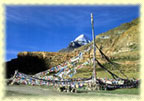|
||||||
 |
||||||
|
||||||||||||||||||||||||||||||||||||||||||||||||||||
|
|
||||||||||||||||||||||||||||||||||||||||||||||||||||
All contents of this website © 2010 Kailashzone Charitable Foundation |
||||||||||||||||||||||||||||||||||||||||||||||||||||
 |
Pilgrims at Mount Kailash and Manasarovar
In the Buddhist world, physical gesture, verbal recitations, and mental concentrations are used simultaneously to establish spiritual understanding and realization. For example, walking around the sacred Mount Kailash, isn't just a walk. Pilgrims use their physical hardship to remind themselves what brought them to walk the sacred mountain. The pilgrims verbally recite prayers, so they can hear themselves and feel it. They mentally concentrate on their prayers and the reason why they are walking.
Every year, there are hundreds of pilgrims who do full body length prostration (Tib. Kyang Cheg) around the sacred Mount Kailash and the holy Manasarovar Lake. Prostration is one of the many practices of Tibetan Buddhism. Prostration is a way of expressing one’s respect to the spiritual superior beings. "Cheg" is the Tibetan term for prostration. In general, there are two ways to do a prostration. "Kyang Cheg" means full body length prostration on the ground. "Kyum Cheng" means bounded body prostration on the ground. Before lying on the ground, the two hands must fold together as if they are sandwiching something. Then, the hands are placed on the crown of the head, which symbolize body. Secondly, the hands are placed by the mouth, which symbolizes speech. Finally, the hands are placed at the center of the heart, which symbolizes mind. All three together symbolize showing respect physically, verbally and mentally.
|
| Sacred
sites at the Mount Kailash | Senge
Tenzin Rinpoche | Ngari:
western Tibet | Limi: northwestern Nepal | Dolpo: eastern Nepal |













 Externally
Bon and Buddhist practitioners look exactly the same. The one obvious
difference between the two faiths is that Bon pilgrims walk counter
clockwise whereas Buddhist pilgrims walk clockwise. They both walk
withspinning prayer wheels while counting rosaries.
Externally
Bon and Buddhist practitioners look exactly the same. The one obvious
difference between the two faiths is that Bon pilgrims walk counter
clockwise whereas Buddhist pilgrims walk clockwise. They both walk
withspinning prayer wheels while counting rosaries. 


